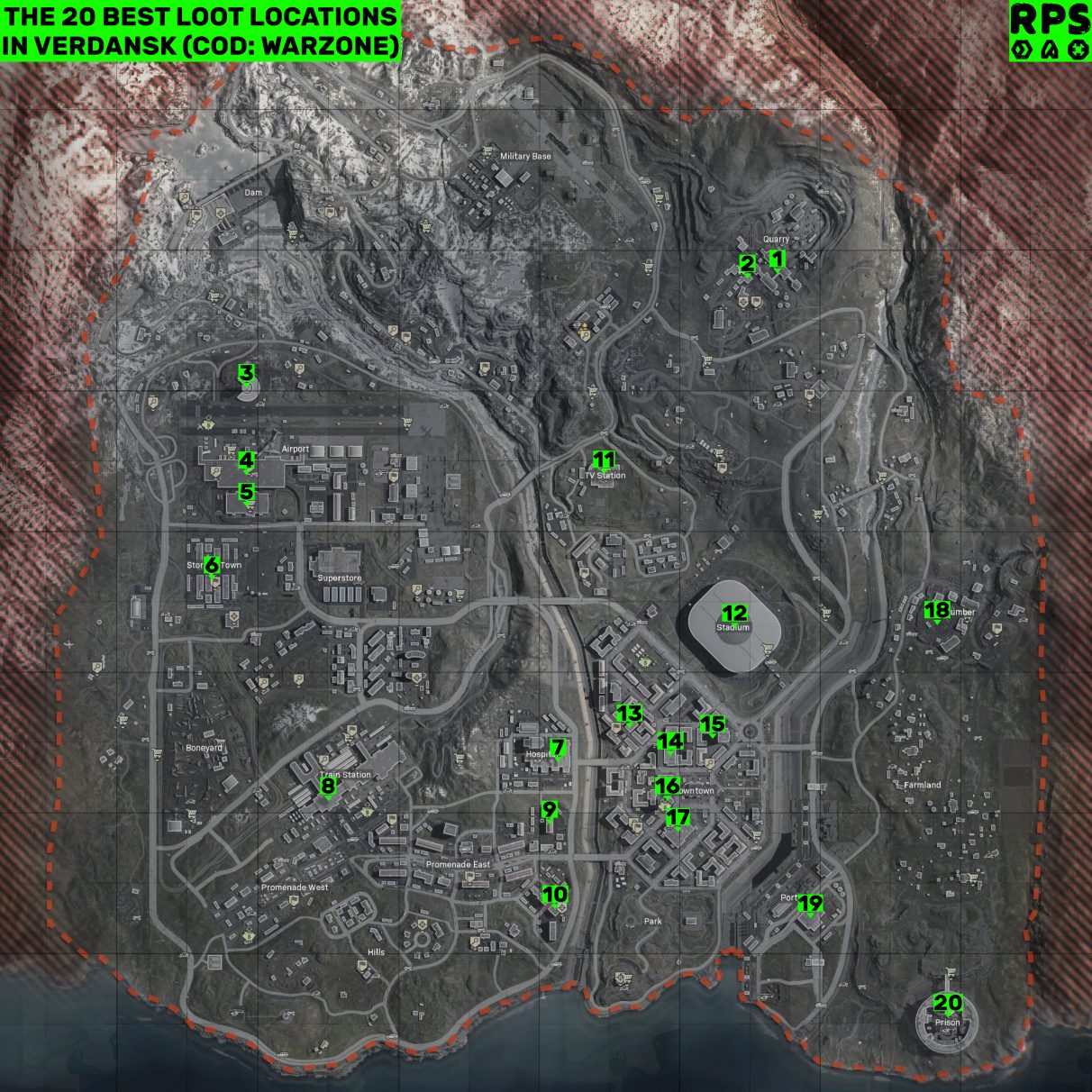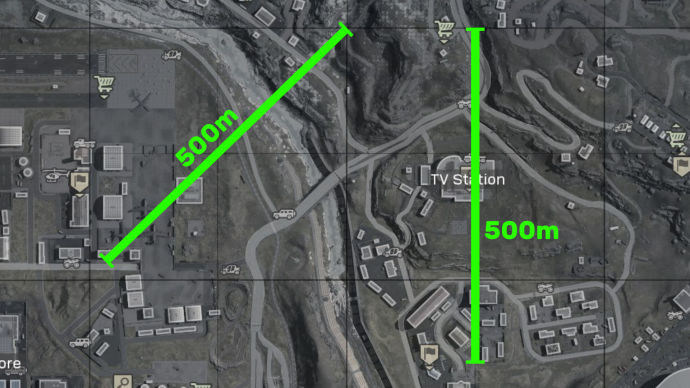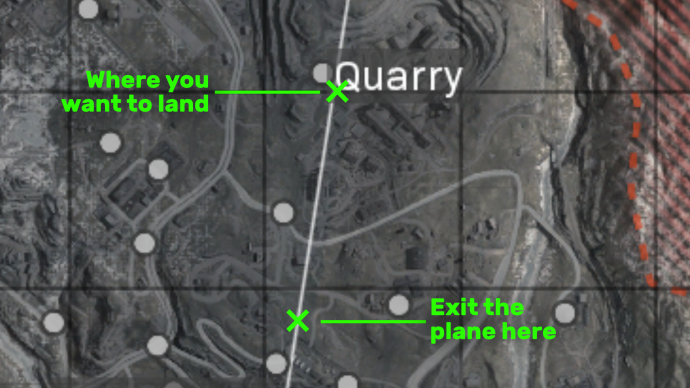Call Of Duty: Warzone landing guide
As with all Battle Royales with a landing phase at the start of the game, there are two big factors that determine your landing method in Warzone: the trajectory of the plane, and your desired landing position. Below we’ll cover the best landing methods for any situation - and also why it might not always be the best idea to land first.
Best landing method (0-500m) Best landing method (500-1400m) Best landing method (1400-1800m) Chuting and Shooting - the problem with landing first If you cut your chute, you won’t automatically redeploy it
Best landing method (0-500m)
If you want to land somewhere that is less than around 500 metres from where you jump out of the plane, you should point your nose right at your desired landing spot, and press forward. Only open your chute early if you need to angle yourself to land on a building roof. Otherwise, just wait for the chute to deploy automatically. It can be hard to see ahead of time how far away your landing spot is from your jump point. But here’s a little tip: see those squares on the map above? They’re also visible whenever you open the Tac Map in-game. Each square is exactly 375m2. So 500m means approximately one-and-a-third squares, or just less than the distance from one corner to the opposite corner. See the below diagram:
The relative elevation of the start and end points will change this slightly, so if you’re aiming for a mountainous region or a very high rooftop, you should shave 10-20% of this distance off, to make sure you get there. Finally: if the plane is flying directly over where you want to drop, it is still best to drop when 500m or so away, rather than waiting until you’re right on top of it. See below:
Best landing method (500-1400m)
If you’re looking to travel much beyond 500m, then you won’t get there just by pointing at it and falling. At these distances, Warzone’s equivalent of wave dropping takes over - or, as I like to call it, the dolphin drop. With the dolphin drop, your aim is to split the overall journey (between jumping from the plane and landing on the ground) into multiple steps by pulling your chute at intervals, and then cutting it again more or less immediately. The reason for this is that after cutting your chute, you have a few seconds before your horizontal velocity is overwhelmed by your vertical velocity, and you can travel a surprising distance across the map. So this method tries as much as possible to stretch that brief interval out so that it covers almost all of the journey from plane to ground, and you can cover as much ground as possible before landing. So that’s the theory. As for how to do it in practice: the key is to keep an eye on your altimeter to the right of your reticule. This altimeter tells you two things: your distance from the ground directly below you; and your velocity. The best way to break your journey into regular steps is to pull your chute the moment you reach a certain velocity. That velocity threshold depends on how far you want to travel. If you’re only travelling 700 metres or so, you’ll only really want to cut your chute once or twice over the entire journey, which means you should probably be cutting your chute at around 100-120 metres per second, if not more. But for longer distances, you’ll need many more steps. From my testing, the maximum distance you can travel with this method (pulling your chute at around 30 metres per second each time) is approximately 1400m. I’ll leave the hours of testing to someone else, but using a little linear interpolation we can make a lazy estimate of the optimal velocity threshold for different distances:
1400m: pull chute every time you reach approx 30m/s 1300m: pull chute every time you reach approx 43m/s 1200m: pull chute every time you reach approx 55m/s 1100m: pull chute every time you reach approx 70m/s 1000m: pull chute every time you reach approx 80m/s 900m: pull chute every time you reach approx 95m/s 800m: pull chute every time you reach approx 107m/s 700m: pull chute every time you reach approx 120m/s
Obviously not only are these numbers estimates, but they must again by altered based on relative elevation, so if you’re heading for a relatively high point like a hill or rooftop then you should shave a good 100+ metres off your estimated distance.
Best landing method (1400-1800m)
If you’re after a quieter start to a Warzone match, your best bet is to head as far away from the plane path as possible. It doesn’t come without any penalties, because you’ll likely reach the ground a whole minute or more after most other players, and thus will be at a disadvantage. But that doesn’t matter much as long as you’re nowhere near anyone else. If you want to travel beyond 1,400 metres, you really shouldn’t be cutting your chute at all. You should pull your chute as early as you can after leaving the plane, look towards the horizon, and just press forwards until you land. From my testing it seems you can reliably cross a good five squares, or roughly 1,800 metres, using this method. Which is almost the entire width of the map. So if your plane path is relatively centred, you can reach just about any point on Verdansk that you’d like. It’s just not very efficient to do so.
Chuting and Shooting - the problem with landing first
Okay: now you know pretty much the best methods for landing for any distance away. Now we get to the part where I explain why it might not always be the best idea to beat everyone to the ground. The reason for this is that, in Warzone, if you cut your chute then you get a few seconds where you’re able to use your weapons to aim and shoot as normal. And seeing as everyone starts the game with a pistol, that means if you’re beating an enemy to the ground, they can pull, cut, and then shoot you from above, ripping away your Armor or even killing you outright before you hit the ground. It’s a fascinating way to balance out the advantage of landing first, and I’m not sure if I like or hate it. For the shooter, there’s really no reason not to shoot and attempt to weaken the enemy beating them. But for the “shootee”, it’s tough to know what to do if you start getting shot at. You can either swerve away, pull your chute, and wait for the enemy to pass you so you become the shooter; or you just cut and weave about, hoping you land before you’re killed. Alternatively, you could adjust your whole drop journey so that you’re arriving slightly later than everyone else. It’s generally the safest route, but only if you land somewhere that’s immediately free of enemies. Otherwise you’re putting yourself at a huge disadvantage.
If you cut your chute, you won’t automatically redeploy it
Finally, a word on something that I’ve seen many players getting confused about. As long as you haven’t cut your chute at all during your landing, then when you reach a tiny altitude above the ground you’ll automatically deploy your chute and save yourself from a grizzly strawberry-jam-esque death. It’s rather frightening, because really it waits far too long to auto-deploy by real life standards, but apparently your player’s legs are made of vibranium so it doesn’t matter to them. But, and here’s the crucial thing: if you have cut your chute at any point during the landing, then that auto-deployment will not happen. You must manually deploy, or you’ll die upon impact with the ground.
Thus concludes our Call Of Duty: Warzone landing guide. Now, while you’re waiting for your next turn to hurtle down towards the massive land of Verdansk, why not check out one or two of our other Warzone guides?



